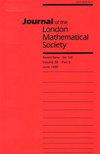素数线性模式的小范围分布
IF 1
2区 数学
Q1 MATHEMATICS
Journal of the London Mathematical Society-Second Series
Pub Date : 2024-09-30
DOI:10.1112/jlms.13001
引用次数: 0
摘要
让 Ψ = ( ψ 1 , ⋯ , ψ t ) : ` Z d → R t $\Psi =(\psi _1,\hdots, \psi _t):`\mathbb {Z}^d\rightarrow \mathbb {R}^t$ 是一个具有有限复杂性的线性形式系统。格林和陶在他们的开创性论文中证明了系统Ψ $\Psi$ 值的以下素数定理:本文章由计算机程序翻译,如有差异,请以英文原文为准。
Small-scale distribution of linear patterns of primes
Let be a system of linear forms with finite complexity. In their seminal paper, Green and Tao showed the following prime number theorem for values of the system :
求助全文
通过发布文献求助,成功后即可免费获取论文全文。
去求助
来源期刊
CiteScore
1.90
自引率
0.00%
发文量
186
审稿时长
6-12 weeks
期刊介绍:
The Journal of the London Mathematical Society has been publishing leading research in a broad range of mathematical subject areas since 1926. The Journal welcomes papers on subjects of general interest that represent a significant advance in mathematical knowledge, as well as submissions that are deemed to stimulate new interest and research activity.

 求助内容:
求助内容: 应助结果提醒方式:
应助结果提醒方式:


